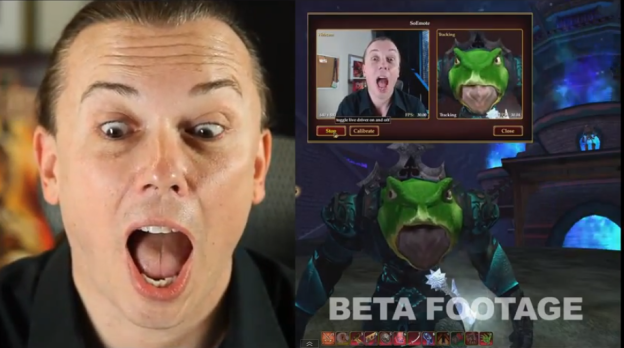
After debuting at E3 earlier this year, EverQuest II’s new SOEmote system has officially gone live in the MMO game world. The tool allows players to make facial expressions that their in-game characters will mimic, and adopt “voice fonts” that alter the way they speak.
Voice fonts are the sort of voice-disguising feature familiar from the spy gadgets store and horror movies: a straightforward pitch-bender that changes your voice to match the character. It’s a small feature, but since built-in, multi-channel voice chat has always been one of Everquest II’s beloved features, it’s nice to see it expanded. Even if it does make you sound like you’re talking through a rubber chicken.
More intriguing is the face — and body– recognition technology, which lets a player enact their facial expressions and some gestures through their in-game avatar. Sony recommends a high-end webcam and plenty of light to prevent “terrible things” from happening, but once you have the camera plugged in, the SOEmote system should start automatically once you install the patch. Smile, wave, or gawp like a hooked trout, then watch your avatar clumsily enact a ghastly simulacrum of human feeling in as close to real-time as your CPU and graphics card will allow.
The SOEmote facial tracking is built on the Live Driver SDK, developed by Image Metrics, which uses any single-source camera to track 64 facial points and capture them 100 times a second, then translate the information onto a character rig. So far EverQuest II and the obscure online game Face Off are the only games to use the technology. If developers can overcome the allegedly severe memory leak issues that are arousing ire on the EverQuest 2 Facebook page, the glitchy performance, and the unjustified but inevitable privacy scares, it seems likely to be implemented in many more online games.
Most MMOs function less as video games and more like virtual malls, where people hang out and socialize. Having character’s voices and translated expressions could go a long way towards making MMO characters as expressive as some of the best characters in the single-player campaign world. Or it might just end up replicating the glazed button-mashing face so ably captured by South Park. The technology also presents interesting opportunities in the world of education. For instance, educational games could help teach children how to read facial expressions, a vital social skill that many children suffering from autism, Asperger’s syndrome, and other learning disabilities find very difficult.
So far, the YouTube documentation of the technology is just a few videos of EverQuest II players and their kids making funny faces at the camera. But Sony hopes to make it much better-known with a contest for the best EverQuest II video to implement SOEmote. It has deliberately left the requirements vague, only saying that whoever makes the most “epic” video will win airfare and accommodations for a trip to SOE Live in Las Vegas. We leave it up to you whether getting flown to a Sony tech demo sounds like a reward or a punishment.


